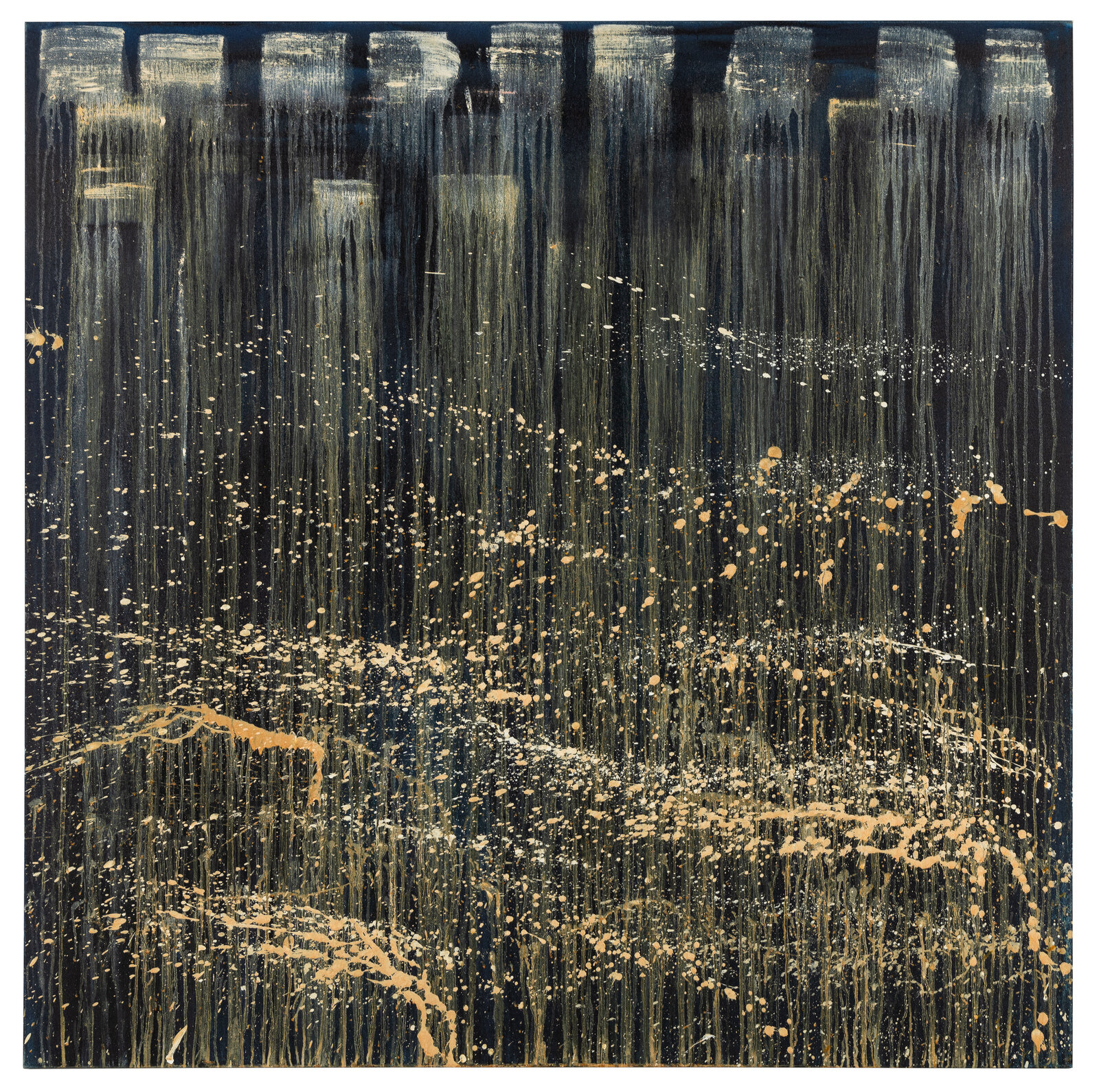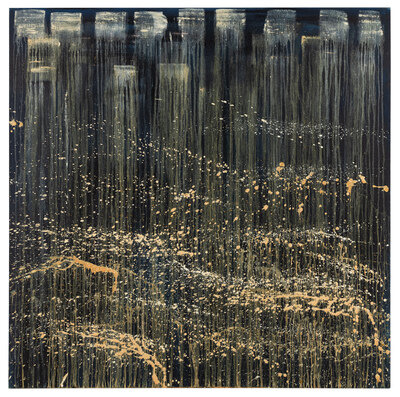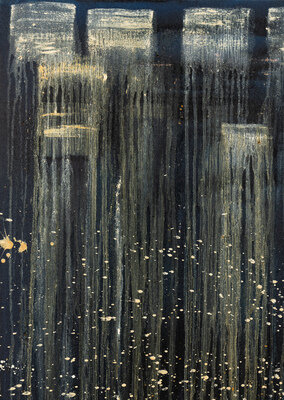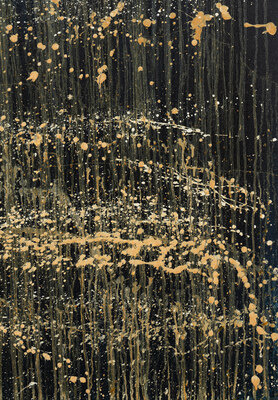Pat Steir
(American, b. 1938)
Small Ghost Waterfall, 1993
Sale 1327 - Post War and Contemporary Art
Apr 24, 2024
10:00AM CT
Live / Chicago
Estimate
$250,000 -
$350,000
Sold for $533,400
Sold prices are inclusive of Buyer’s Premium
Lot Description
Pat Steir
(American, b. 1938)
Small Ghost Waterfall, 1993
oil on canvas
initialed PS and dated (verso)
59 x 59 inches.
Property from the Estate of Renee and Sandy Bank
Provenance:
Jaffe Baker Blau, Boca Raton (as Untitled)
Robert Miller Gallery, New York
Purchased from the above by the present owner in 1998
Lot Essay:
Creating Atmosphere: Pat Steir’s Waterfalls
Dedicated to abstraction, artist Pat Steir (American, b. 1938) is nevertheless able to invoke a strong sense of atmosphere in her paintings. This is the case in Small Ghost Waterfall (1993), a painting from Steir’s most well-known series, Waterfalls, in which she uses a variety of mark-making techniques emphasizing movement and chance and a connection between word and image to immerse the viewer into the painting’s specific frame of mind.
In Small Ghost Waterfall, streams of white, pale yellow, and olive drip over a dark blue ground, imprints from brushes laden with paint. Flung yellow, white, and orange streak over the drips. The order of operations is mapped throughout the painting’s surface. Like Jackson Pollack and other Abstract Expressionist painters, the physicality and performance of the work is clear; however, unlike Pollack, the painting could only have been made verticality, with the work hanging on the wall to face the effects of both artist and gravity.
In addition to Abstract Expressionism, Steir has been heavily influenced by both Chinese and Japanese art as well as John Cage and his application of chance in his work. Steir first visited Japan in the early 1980s, beginning a lifelong admiration for Japanese and Chinese art and culture. Particularly apparent in the case of the Waterfalls series was her appreciation of the ink paintings and landscapes of the Chinese Tang (618-907) and Song (960-1279) dynasties, especially the ink splash painters of the Tang dynasty, some of whom experimented with creating compositions from ink first splashed by chance.[i] This preoccupation with chance was likewise a foremost consideration of artist John Cage. As noted by Steir regarding her process:
The waterfall paintings are painted as though the waterfall is directly in front of the artist, chaotic but confrontational. I’ve always admired John Cage; his whole system involved chaos. I’m trying desperately to make chaos, but I make order. I try to make the chaos within the work; that’s why I depend on gravity to leave a lot of space for accident. For chaos.[ii]
The painting makes manifest Steir’s applied elements of chaos through chance as well as her physical movements at the time of making. Steir underlines her intentions through the additional connection between word and image and the further associations of the work with poetic imagery. She usually tries to keep the number of words her painting titles to not many more than two so that she can “picture the painting in my mind’s eye when the title is spoken”.[iii] This link to her personal memory and its evocation is crucial to her process. She notes “the poetry of the title is part of the picture for me, it’s absolutely the same thing.”[iv]
The poetry of Small Ghost Waterfall lends associations to the viewer despite the painting’s overall abstraction. The cool tones—from the deep blues to the pale yellows to the subtle greens—emphasize the ethereal quality of the work, while the streams of dripped paint evoke the sounds of torrents of water, punctuated by frothy bursts at the top of the canvas from textured paintbrush impressions, accompanied by the pattering of paint blotches further suggesting watery connotations. Steir uses her title and the physicality of her work to envelop the viewer into the scene of Small Ghost Waterfall.
The square format of the painting prioritizes neither vertical nor horizontal space, situating the viewer directly in the center of the work. Strong verticals from the drips are then interspersed with the horizontal lines of paint whipped at the canvas, with the alternating lines of yellow and white creating a natural zig zag across the length of the canvas, as the eye travels back and forth and then is redirected back to the top of the canvas to the dark negative space of the navy ground, to begin anew. New details are to be discovered dancing through the balanced composition—a variety of textures and colors—glistening drops of orange, surprising and welcome swipes of pink near the top. The painting expertly enmeshes the viewer in the ghosts of Steir’s prior activity, an imprint of her whirls and deliberate stamps of gravity-altered paint and poetic association to continually recreate the atmosphere of rushing wine-dark waterfall.
Bibliography:
Waldman, Anne. “Gravity and Levity: stop start wait go: Pat Steir’s Poethics.” In Pat Steir. New York:
Cheim & Read, 2007.
Waldman, Anne. “Interview: Pat Steir.” BOMB, April 1, 2003.
https://bombmagazine.org/articles/2003/04/01/pat-steir/.
[i] Anne, Waldman, “Gravity and Levity: stop start wait go: Pat Steir’s Poethics,” in Pat Steir (New York: Cheim & Read, 2007).
[ii] Anne Waldman, “Interview: Pat Steir.” BOMB, April 1, 2003, https://bombmagazine.org/articles/2003/04/01/pat-steir/.
[iii] Ibid.
[iv] Ibid.
Condition Report
Unframed.
The physical condition of lots in our auctions can vary due to
age, normal wear and tear, previous damage, and
restoration/repair. All lots are sold "AS IS," in the condition
they are in at the time of the auction, and we and the seller make
no representation or warranty and assume no liability of any kind
as to a lot's condition. Any reference to condition in a catalogue
description or a condition report shall not amount to a full
accounting of condition. Condition reports prepared by Hindman
staff are provided as a convenience and may be requested from the
Department prior to bidding.
The absence of a posted condition report on the Hindman website or
in our catalogues should not be interpreted as commentary on an
item's condition. Prospective buyers are responsible for
inspecting a lot or sending their agent or conservator to inspect
the lot on their behalf, and for ensuring that they have
requested, received and understood any condition report provided
by Hindman.
Please email fineart@hindmanauctions.com for any additional information or questions you may have regarding this lot.







